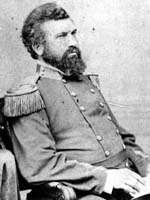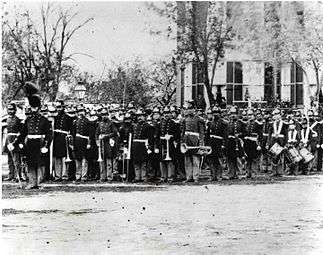Francesco Maria Scala
| Francesco Maria Scala | |
|---|---|
 Scala in the uniform of a U.S. Marine | |
| Birth name | Francesco Maria Scala |
| Nickname(s) | "Francis" |
| Born |
1819 Naples, Italy |
| Died |
April 18, 1903 Washington, D.C., U.S. |
| Buried at |
|
| Allegiance | |
| Service/branch |
|
| Years of service |
|
| Rank |
|
| Commands held |
|
| Battles/wars | |
Francesco Maria Scala (1819 – 18 April 1903) also known as Francis M. Scala, was an Italian-born naturalized American military band director and musician. He was the first and one of the most important and influential directors of United States Marine Corp (USMC) Band. He defined the instrumental organization that the band maintains, he was an extremely prolific musician and composer, and improved and enlarged the repertoire of the ensemble.[1] It is thought that under his direction the USMC Band executed for the first time the melody "Potpourri-Fantasie" from the opera Geneviève de Brabant by Jacques Offenbach. This melody is now known as the Marines' Hymn.[2]
Biography
Born in Naples around 1819,[3][4] despite his family had no musical traditions, he precociously developed a strong passion for music. He was admitted as a student at the San Pietro a Maiella Conservatory in Naples, where he graduated as a clarinet soloist.
In 1841, according to his own words "at the age of about twenty",[5] he embarked as a "third-class musician" on the US fregate USS Brandywine, of the Mediterranean Squadron.[6]
He soon discovered he suffered from sea sickness, therefore he resigned from the US Navy and on August 11, 1842 he joined the USMC Band in Washington. His capabilities were soon appreciated, and he was promoted "Fife Major" on May 22, 1843.
On September 9, 1855 he succeeded Rafael Triay as 14th band director, or Drum Major. Before him, other twelve musicians alternated as band leaders from its foundation in 1799, among which other two Italians: Venerando Pulizzi (1816–17; 1818–27) and Joseph Lucchesi (1844–46). Scala was however the very first musician officially bestowed with the title of Band Director by a decree issued on July 25, 1861. After him, there was only one other Italian Band Director, Francesco Fanciulli (between 1892-1897).
During his 16 years of tenure, Scala decined the instrumental configuration that the band maintains.[7] He increased the dimension of the band from the ten elements he found when taking leadership, to the about 35 when he retired. He also took the far-sighted decision to maintain an equilibrated relationship between woodwind and brass, in a period when brass were prevalent in the bands.

As all the Marine Band directors, Scala maintained a very strict relationship with the various American Presidents, that the Band accompanied during their official visits. Scala became Band Director during the President Buchanan mandate. In particular, Scala directed the band during the whole War of Secession, during which he developed a very strict and strong relationship with president Abraham Lincoln, to which he had already dedicated a special concert in his honor the same night of his election. During the Civil War, president Lincoln maintained that the Marine Band continued to regularly offer its concerts in the front lawn of the White House, even if when President's son died, they were moved to the Lafayette Square in sign of respect. Scala was with Lincoln in Gettysburg on November 19, 1863 for the inauguration of the National Cemetery when Lincoln pronounced his famous address, and he was with him on the White House lawn on April 9, 1865, when the news about the surrounding of the Confederate Army arrived. Under Lincoln's request, the band played the tune "Dixie", because - as the President said from his balcony - "now it is of the Nation's". Eleven days after, the band expressed country's mourning while accompanying Lincoln's coffin during his funeral.[8]
Scala was an extremely prolific musician and arranger, and he improved and enlarged a good deal the repertoire of the ensemble. Thanks to his divulgative activity of the European and Italian opera music he pushed the Marine Band toward a more concertistic approach, thus freeing it from the sole military executions. Under the direction of Scala, the young John Philip Sousa started his own apprenticeship in the Band (where his father already played) on June 9, 1868.[9]
Scala ended his mandate as Marine Band director on December 13, 1871. He spent the rest of his life in Washington, in his house of South Carolina Avenue. When he died on April 18, 1903, the Marine Band played his preferred hymn Nearer My God to Thee during his funerals from his house and the Catholic church of St. Peter, and while in the church, it played the arrangement written by the late director for the funeral tune from Il trovatore by Giuseppe Verdi.
Scala's music collection is conserved at the Library of Congress in Washington, to which it was donated in 1952 by his son, together with a fund that covers expenses for its study and execution. It included more than 600 titles between original works (marches, waltz, etc.) and transcriptions and arrangements from his operatic repertoire, particularly from the Italian composers Giuseppe Verdi and Gioacchino Rossini.
Bibliography
- Clark, Allen C. “Francis Maria Scala: A Leader of the Band, U.S. Marine Corps.” Unpublished transcript of a paper read before the Columbia Historical Society. 21 March 1933. Washington, D.C. U.S. Marine Band Archives.
- “Congressional Cemetery.” Pamphlet published by Congressional Cemetery Association (1801 E Street, SE) Washington, D.C.
- Della Fonte, Lorenzo "L'infinita musica del vento", ed. Casa Musicale Eco, 2014 (novel)
- “Francis Scala, Director of Famous Marine Band for Thirty Years.” The Morning Times (Washington), 26 April 1903.
- Ingalls, David M. Francis Scala: Leader of the Marine Band from 1855 to 1871. M.A. Dissertation, Catholic University of America, 1957.
- Kirk, Elise K. Music at the White House. Urbana: University of Illinois Press, 1986.
- “Scala’s Glorious Past.” Undated newspaper clipping. Washington, D.C. U.S. Marine Band Archives.
- Washington, D.C. U.S. Marine Band Archives.
External links
- United States Marine Band Official Site
- A History of the United States Marine Band, by Col. John R. Bourgeois
Notes
- ↑ The Directors of USMC Band - The White House Historical Association
- ↑ Francis M. Scala, biography on the USMC Band website
- ↑ Scholars have not still reached a consensus about his date of birth
- ↑ Francis M. Scala, Biography on the official website of USMC Band. Access July 27, 2015.
- ↑ This evidence would put his date of birth around 1820-1821
- ↑ Francis M. Scala, Biography on the official website of USMC Band. Access July 27, 2015.
- ↑ The Directors of USMC Band - The White House Historical Association
- ↑ A History of the United States Marine Band, by Col. John R. Bourgeois
- ↑ A History of the United States Marine Band, by Col. John R. Bourgeois